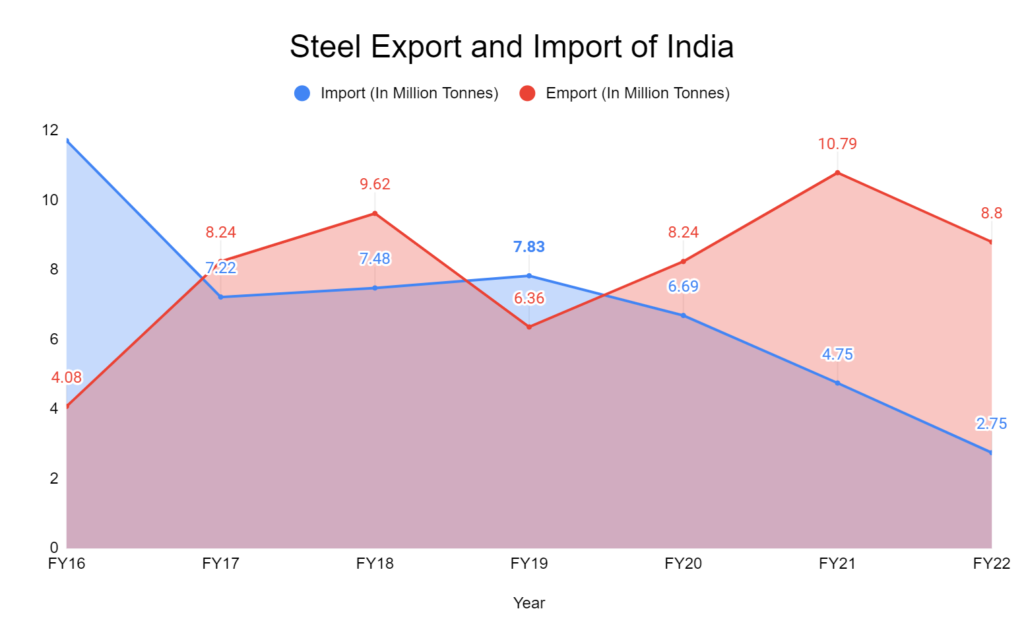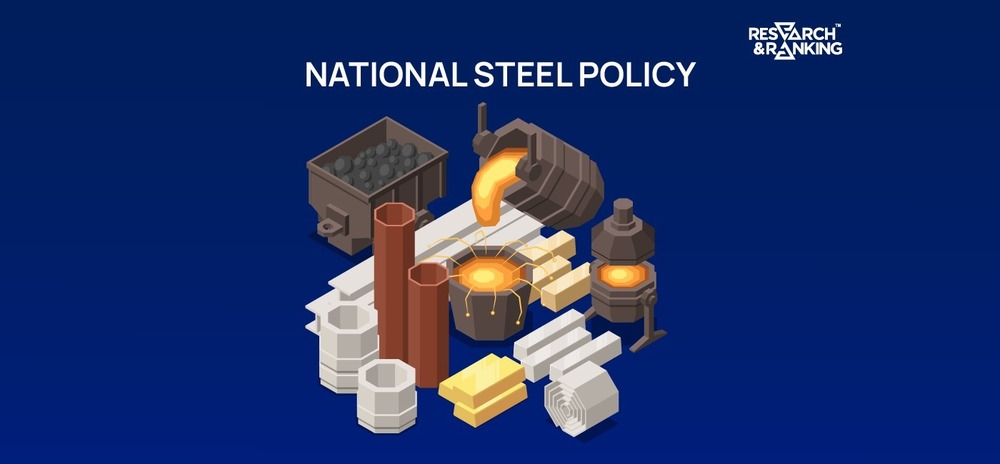Steel is one of the most essential materials for any industrial economy. It has wide applications in various sectors, such as construction, infrastructure, power, defense, automotive, consumer goods, machinery, etc. With the forward and backward linkages with these industries, it is also a key driver of economic growth and employment generation, so much so that the steel sector contributes about 2.5% of the country’s GDP.

Since a flourishing steel industry is crucial for India’s rapid economic development and industrialization, the National Steel Policy (NSP) 2017 has outlined the goals and objectives of the Indian steel sector for the next decade. The comprehensive document aims to achieve a steel production capacity of 300 million tonnes (MT) by 2030, up from 154.06 MT in 2021-22. The policy also looks at increasing the per capita consumption of steel to 160 kg by 2030 from the present level of 69 kg. It has a long-term vision to enhance domestic consumption, produce high-quality steel, and make the sector globally competitive.
How will the NSP 2017 help the Indian steel sector achieve its vision?
The NSP 2017 provides a roadmap for the Indian steel sector to achieve its vision of becoming a globally competitive and self-reliant industry. The policy has set various targets and strategies for the sector, such as:
- Increasing the crude steel capacity to 300 MT by 2030-31 will require an investment of about Rs.10 lakh crore.
- Meeting the demand for high-grade automotive steel, special steels and alloys, and electrical steel for strategic applications through domestic production by 2030-31.
- Developing a globally competitive steel industry that is energy and raw-material-efficient, environmentally sustainable, socially responsible, and technologically advanced.
What is the impact of the NSP 2017 on the stock market?
The NSP 2017 positively impacts the stock market, signaling the government’s commitment and support to the steel sector. The policy also creates a favorable environment for the steel companies to expand their capacities, improve their quality and efficiency, and increase their profitability and market share.
The policy also boosts the confidence and sentiment of the investors, who see the potential and opportunities in the steel sector. Here are the 3 stocks the NSP could affect:
- JSW Steel Ltd: The largest steel producer in India has a capacity of 18 MT and a market share of 15%. It has a diversified product mix, catering to various end-use sectors such as automotive, construction, infrastructure, defense, and energy. With a strong focus on innovation, quality, and sustainability, JSW has invested in several greenfield and brownfield projects to enhance its capacity and efficiency. It has a market capitalization of Rs.1,99,965 crore, a one-year return of 18.8%, and a five-year average return on investment of 23.5%.
- Tata Steel Ltd: India’s second-largest steel producer, with a capacity of 13 MT and a market share of 13%; it has a wide range of products, serving various segments such as automotive, construction, engineering, consumer goods, and packaging. It has a strong presence in domestic and international markets and has acquired several European and Asian steel companies. It has a market capitalization of Rs. 1,79,950 crore, a one-year return of 34.4%, and a five-year average return on investment of 23.3%.
- Jindal Steel and Power Ltd: The third-largest steel producer in India, with a capacity of 8.6 MT and a market share of 9%, has a diversified product portfolio comprising long products, flat products, rails, plates, pipes, and pellets. It has a strong presence in the infrastructure, power, mining, and defense sectors and has undertaken several mega projects in India and abroad. It has a market capitalization of Rs. 79,215 crore, a one-year return of 37.5%, and a five-year average return on investment of 39.4 %.
Also Read: Exploring Socially Responsible Investment
Conclusion
The NSP 2017 is a visionary and strategic policy that aims to transform the Indian steel sector into a world-class industry. The policy addresses the sector’s challenges and opportunities and provides a clear direction and roadmap for its growth and development. It also has a positive impact on the stock market, as it enhances the attractiveness and competitiveness of the steel sector.
Furthermore, the policy is expected to create a multiplier effect on the economy, generating employment, income, investment, innovation, and exports. It will also contribute to the national goals of Atmanirbhar Bharat, Make in India, and Digital India. The NSP 2017 will be a game-changer for the Indian steel sector and a catalyst for its future success!
*Disclaimer Note: The securities quoted, if any, are for illustration only and are not recommendatory. This article is for education purposes only and shall not be considered as recommendation or investment advice by Research & Ranking. We will not be liable for any losses that may occur. Investment in securities market are subject to market risks. Read all the related documents carefully before investing. Registration granted by SEBI, membership of BASL, and certification from NISM in no way guarantee the performance of the intermediary or provide any assurance of returns to investors.
FAQs
What is the National Steel Policy 2017?
A policy that sets the goals and vision for the Indian steel sector for the next decade, targeting to reach 300 million tonnes of steel production by 2030.
How will it help the steel sector?
The NSP will help increase the steel industry's capacity, quality, efficiency, and competitiveness.
How will it affect the stock market?
The National Steel Policy will create a favorable environment for the steel companies and boost investor confidence and sentiment.
How useful was this post?
Click on a star to rate it!
Average rating 5 / 5. Vote count: 1
No votes so far! Be the first to rate this post.
I’m Archana R. Chettiar, an experienced content creator with
an affinity for writing on personal finance and other financial content. I
love to write on equity investing, retirement, managing money, and more.
-
Archana Chettiarhttps://www.equentis.com/blog/author/archana/
-
Archana Chettiarhttps://www.equentis.com/blog/author/archana/
-
Archana Chettiarhttps://www.equentis.com/blog/author/archana/
-
Archana Chettiarhttps://www.equentis.com/blog/author/archana/

